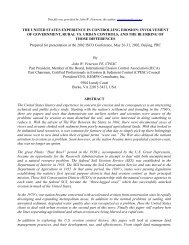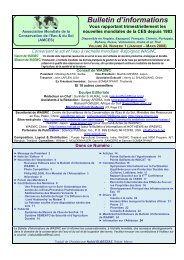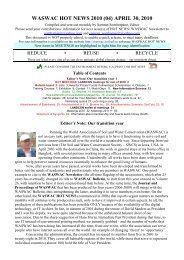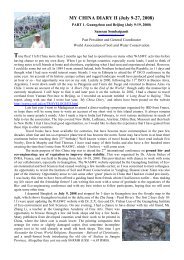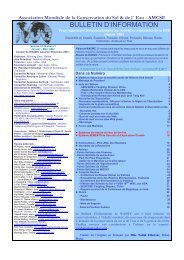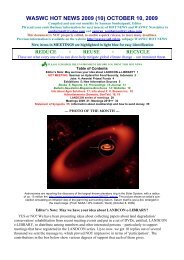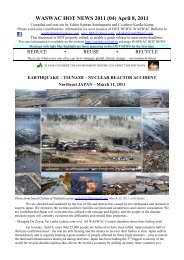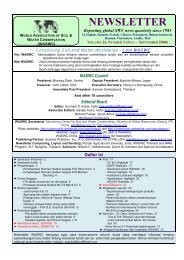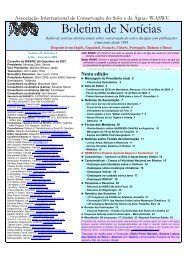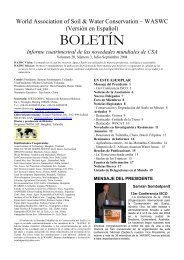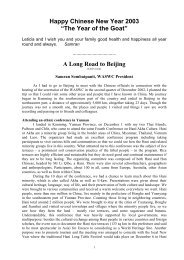Even if 100 percent <strong>of</strong> <strong>the</strong> ped surfaces are covered by clay skins, <strong>the</strong> thin section will in its major part be occupied by <strong>the</strong>matrix <strong>of</strong> <strong>the</strong> soil and voids.Diagnostic criteria. An argic horizon must have:1. texture <strong>of</strong> sandy loam or finer and at least 8 percent clay in <strong>the</strong> fine earth fraction; and2. more total clay than an overlying coarser textured horizon (exclusive <strong>of</strong> differences which result from alithological discontinuity only) such that:a. if <strong>the</strong> overlying horizon has less than 15 percent total clay in <strong>the</strong> fine earth fraction, <strong>the</strong> argic horizonmust contain at least 3 percent more clay; orb. if <strong>the</strong> overlying horizon has 15 percent or more and less than 40 percent total clay in <strong>the</strong> fine earthfraction, <strong>the</strong> ratio <strong>of</strong> clay in <strong>the</strong> argic horizon to that <strong>of</strong> <strong>the</strong> overlying horizon must be 1.2 or more; orc. if <strong>the</strong> overlying horizon has 40 percent or more total clay in <strong>the</strong> fine earth fraction, <strong>the</strong> argic horizon mustcontain at least 8 percent more clay; and3. an increase in clay content within a vertical distance <strong>of</strong> 30 cm if an argic horizon is formed by clay illuviation. Inany o<strong>the</strong>r case <strong>the</strong> increase in clay content between <strong>the</strong> overlying and <strong>the</strong> argic horizon must be reached within avertical distance <strong>of</strong> 15 cm; and4. autochthonous rock structure is absent in at least half <strong>the</strong> volume <strong>of</strong> <strong>the</strong> horizon; and5. thickness <strong>of</strong> at least one tenth <strong>of</strong> <strong>the</strong> sum <strong>of</strong> <strong>the</strong> thickness <strong>of</strong> all overlying horizons and at least 7.5 cm thick. If <strong>the</strong>argic horizon is entirely composed <strong>of</strong> lamellae, <strong>the</strong> lamellae must have a combined thickness <strong>of</strong> at least 15 cm.The coarser textured horizon overlying <strong>the</strong> argic horizon must be at least 18 cm thick or 5 cm if <strong>the</strong> texturaltransition to <strong>the</strong> argic horizon is abrupt (see abrupt textural change, in diagnostic properties).Field identification. Textural differentiation is <strong>the</strong> main feature for recognition <strong>of</strong> argic horizons in <strong>the</strong> field. The illuvialnature may be established in <strong>the</strong> field using a x10 hand-lens if clear clay skins occur on ped surfaces, in fissures, in poresand in channels. An 'illuvial' argic horizon should at least in some part show clay skins on at least 5 percent <strong>of</strong> bothhorizontal and vertical ped faces and in <strong>the</strong> pores. Clay skins are <strong>of</strong>ten difficult to detect in soils with a smectiticmineralogy as <strong>the</strong>se are destroyed regularly by shrink-swell movements. The presence <strong>of</strong> clay skins in 'protected' positions,e.g. in pores, should be sufficient to meet <strong>the</strong> requirements for an 'illuvial' argic horizon.Additional characteristics. The illuvial character <strong>of</strong> an argic horizon can best be established using thin sections. Diagnostic'illuvial' argic horizons must show areas with oriented clays that constitute on average at least 1 percent <strong>of</strong> <strong>the</strong> entire crosssection.O<strong>the</strong>r tests involved are particle size distribution analysis, to determine <strong>the</strong> increase in clay content over a specifieddepth, and <strong>the</strong> fine clay 4 /total clay analysis. In 'illuvial' argic horizons <strong>the</strong> fine clay/total clay ratio is larger than in <strong>the</strong>overlying horizons, caused by preferential eluviation <strong>of</strong> fine clay particles. If <strong>the</strong> soil shows a lithological discontinuityover or within <strong>the</strong> argic horizon, or if <strong>the</strong> surface horizon has been removed by erosion, or if only a plough layer overlies<strong>the</strong> argic horizon, <strong>the</strong> illuvial nature must be clearly established. A lithological discontinuity, if not clear from <strong>the</strong> field(data), can be identified by <strong>the</strong> percentage <strong>of</strong> coarse sand, fine sand and silt, calculated on a clay-free basis (internationalparticle size distribution or using <strong>the</strong> additional groupings <strong>of</strong> <strong>the</strong> USDA system or o<strong>the</strong>r), or by changes in <strong>the</strong> content <strong>of</strong>gravel and coarser fractions. A change <strong>of</strong> at least 20 percent (relative) <strong>of</strong> any <strong>of</strong> <strong>the</strong> major particle size fractions can beregarded as diagnostic for a lithological discontinuity. However, it should only be taken into account if it is located in <strong>the</strong>section <strong>of</strong> <strong>the</strong> pr<strong>of</strong>ile where <strong>the</strong> clay increase occurs and if <strong>the</strong>re is evidence that <strong>the</strong> overlying layer was coarser textured.Although this is a simplified way <strong>of</strong> treating lithological discontinuities, not much more can be done with <strong>the</strong> datacommonly available. On <strong>the</strong> o<strong>the</strong>r hand, particle size discontinuities are <strong>of</strong> main interest for <strong>the</strong> argic horizon and will showif <strong>the</strong> overlying material was very much different and coarser, even without considering clay loss due to eluviation or o<strong>the</strong>rprocesses. Relationships with some o<strong>the</strong>r diagnostic horizons. Argic horizons are normally associated with and situatedbelow eluvial horizons, i.e. horizons from which clay and iron have been removed. Although initially formed as asubsurface horizon, argic horizons may occur at <strong>the</strong> surface as a result <strong>of</strong> erosion or removal <strong>of</strong> <strong>the</strong> overlying horizons.Some clay-increase horizons may have <strong>the</strong> set <strong>of</strong> properties which characterize <strong>the</strong> ferralic horizon, i.e. a low CEC andECEC (effective CEC), a low content <strong>of</strong> water-dispersible clay and a low content <strong>of</strong> wea<strong>the</strong>rable minerals, all over a depth<strong>of</strong> 50 cm. In such cases a ferralic horizon has preference over an argic horizon for classification purposes. However, anargic horizon prevails if it overlies a ferralic horizon and it has, in its upper part over a depth <strong>of</strong> 30 cm, 10 percent or morewater-dispersible clay, unless <strong>the</strong> soil material has geric properties or more than 1.4 percent organic carbon. Argic horizonsalso lack <strong>the</strong> structure and sodium saturation characteristics <strong>of</strong> <strong>the</strong> natric horizon.4 Fine clay:
Calcic horizonGeneral description. The calcic horizon (from L. calx, lime) is a horizon in which secondary calcium carbonate (CaCO 3 )has accumulated ei<strong>the</strong>r in a diffuse form (calcium carbonate present only in <strong>the</strong> form <strong>of</strong> fine particles <strong>of</strong> 1 mm or less,dispersed in <strong>the</strong> matrix) or as discontinuous concentrations (pseudomycelia, cutans, s<strong>of</strong>t and hard nodules, or veins). Theaccumulation may be in <strong>the</strong> parent material, or in subsurface horizons, but it can also occur in surface horizons as a result<strong>of</strong> erosion. If <strong>the</strong> accumulation <strong>of</strong> s<strong>of</strong>t carbonates becomes such that all or most <strong>of</strong> <strong>the</strong> pedological and/or lithologicalstructures disappear and continuous concentrations <strong>of</strong> calcium carbonate prevail, <strong>the</strong> horizon is named a hypercalcichorizon (from Gr. hyper, superseding, and L. calxis, lime).Diagnostic criteria. A calcic horizon must have:1. calcium carbonate equivalent content in <strong>the</strong> fine earth fraction <strong>of</strong> 15 percent or more (for hypercalcic horizonsmore than 50 percent calcium carbonate equivalent in <strong>the</strong> fine earth fraction); and2. thickness at least 15 cm, also for <strong>the</strong> hypercalcic horizon.Field identification. The presence <strong>of</strong> calcium carbonate can be identified in <strong>the</strong> field using a 10% HCl solution. The degree<strong>of</strong> effervescence (audible only, visible as individual bubbles, or foam-like) is an indication <strong>of</strong> <strong>the</strong> amount <strong>of</strong> lime present.This test is important if only diffuse distributions are present.O<strong>the</strong>r indications for <strong>the</strong> presence <strong>of</strong> a calcic or hypercalcic horizon are:1. soil colours which are more or less white, pinkish to reddish, or grey; and2. a low porosity (inter-aggregate porosity in <strong>the</strong> (hyper-)calcic horizon is usually less than that in <strong>the</strong> horizonimmediately above and possibly also less than in <strong>the</strong> horizon directly underneath).Calcium carbonate content may decrease with depth, but this is <strong>of</strong>ten difficult to establish, particularly if<strong>the</strong> calcic horizon occurs in <strong>the</strong> deeper subsoil. Accumulation <strong>of</strong> secondary lime is <strong>the</strong>refore sufficient todiagnose a (hyper-)calcic horizon.Additional characteristics. Determination <strong>of</strong> <strong>the</strong> amount <strong>of</strong> calcium carbonate (by weight) and <strong>the</strong> changes within <strong>the</strong> soilpr<strong>of</strong>ile <strong>of</strong> <strong>the</strong> calcium carbonate content are <strong>the</strong> main analytical criteria for establishing <strong>the</strong> presence <strong>of</strong> a calcic horizon.Determination <strong>of</strong> <strong>the</strong> pH (H 2 O) enables distinction between accumulations with a basic ('calcic') character (pH 8.0 - 8.7)due to <strong>the</strong> dominance <strong>of</strong> CaCO 3 , and those with an ultrabasic ('non-calcic') character (pH > 8.7) because <strong>of</strong> <strong>the</strong> presence <strong>of</strong>MgCO 3 or Na 2 CO 3 . In addition, microscopical analysis <strong>of</strong> thin sections may reveal <strong>the</strong> presence <strong>of</strong> dissolution forms inhorizons above or below a calcic horizon, evidence <strong>of</strong> silicate epigenesis (isomorphous substitution <strong>of</strong> quartz by calcite), or<strong>the</strong> presence <strong>of</strong> o<strong>the</strong>r calcium carbonate accumulation structures, while clay mineralogical analyses <strong>of</strong> calcic horizons <strong>of</strong>tenshow clays characteristic <strong>of</strong> confined environments, such as montmorillonites, attapulgites and sepiolites. Relationshipswith some o<strong>the</strong>r diagnostic horizons. When hypercalcic horizons become indurated, transition takes place to <strong>the</strong> petrocalcichorizon, <strong>the</strong> expression <strong>of</strong> which may be massive or as platy structures. In dry regions and in <strong>the</strong> presence <strong>of</strong> sulphatebearingsoil- or groundwater solutions, calcic horizons occur associated with gypsic horizons. Calcic and gypsic horizonsusually occupy different positions in <strong>the</strong> soil pr<strong>of</strong>ile because <strong>of</strong> <strong>the</strong> difference in solubility <strong>of</strong> calcium carbonate andgypsum, and normally <strong>the</strong>y can be clearly distinguished from each o<strong>the</strong>r by <strong>the</strong> difference in morphology. Gypsum crystalstend to be needle-shaped, <strong>of</strong>ten visible with <strong>the</strong> naked eye, whereas pedogenetic calcium carbonate crystalsare much finerin size.Ferric horizonGeneral description. The ferric horizon (from L. ferrum, iron) is a horizon in which segregation <strong>of</strong> iron has taken place tosuch an extent that large mottles or concretions have formed and <strong>the</strong> inter-mottle/inter-concretionary matrix is largelydepleted <strong>of</strong> iron. Generally, such segregation leads to poor aggregation <strong>of</strong> <strong>the</strong> soil particles in iron-depleted areas andcompaction <strong>of</strong> <strong>the</strong> horizon.Diagnostic criteria. A ferric horizon must have:1. many (more than 15 percent <strong>of</strong> <strong>the</strong> exposed surface area) coarse mottles with hues redder than 7.5YR and chromemore than 5, or both; or2. discrete nodules, up to 2 cm in diameter, <strong>the</strong> exteriors <strong>of</strong> <strong>the</strong> nodules being enriched and weakly cemented orindurated with iron and having redder hues or stronger chrome than <strong>the</strong> interiors; and3. thickness <strong>of</strong> at least 15 cm.73




